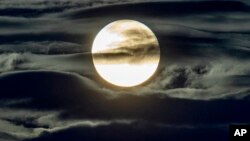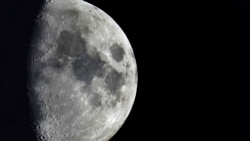American scientists are working to develop a telescope to deploy on the moon.
The telescope is designed to search for ancient radio waves that could provide important details about the early universe.
The American space agency NASA and the U.S. Department of Energy are working together on the project.
The telescope will be the first designed to collect data on a historical period of the universe called the Dark Ages. This period is considered important to study because it can provide new details about the formation and development of the universe.
The Dark Ages period began nearly 380,000 years after the Big Bang, the explosion many scientists believe created the universe. During the Dark Ages, there were no stars or planets.
In a statement announcing the project, NASA said information on the Dark Ages can only be learned through data collected from radio waves. The new telescope is specially designed to provide details on the formation of the early universe.
The telescope is to be placed on what is known as the far side of the moon. This description came about because that side of the moon cannot be seen from Earth. The area does experience its own day and night cycle.
The far side of the moon enjoys radio silence compared to Earth, which experiences so much radio wave traffic it is considered noise “pollution.” It offers an unusual environment that permits researchers to record sensitive radio signals. Team members say such signals cannot be captured anywhere else in near-Earth space.
Anže Slosar is a physicist with the Department of Energy’s Brookhaven National Laboratory in New York. He said in a statement that studying the universe is easier when collecting data from a time before the stars and planets formed.
“So far, we can only make predictions about earlier stages of the universe using a benchmark called the cosmic microwave background,” Slosar said. He noted that the new telescope would provide a new benchmark, opening the door for scientists to make further important discoveries about the universe.
After touching down on the moon, the telescope’s lander will turn off permanently so it does not produce any wave interference. The telescope will then deploy four three-meter-long antennas. The instrument must survive the severe conditions existing on the moon’s far side.
Scientists on Earth will have to wait 40 days for the telescope to collect and send its first data to a satellite that can communicate with Earth.
Researchers leading the project say multiple big discoveries could be made in the future with the lunar telescope.
"Radio emission from the galaxy is very bright and our Dark Ages signal is hiding behind it” said physicist Stuart D. Bale of the University of California, Berkeley.
Paul O’Connor is a scientist with Brookhaven’s Instrumentation Division who is helping lead the project. “The moon is easier to reach than Mars, but everything else is more challenging,” he said about the operating environment on the moon.
O’Connor added that removing heat and avoiding radiation are some of the main challenges faced when exploring from the moon. “There's a reason only one robotic rover has landed on the Moon in the last 50 years, while six went to Mars, which is 100 times farther away,” O’Connor said.
I’m Bryan Lynn.
Bryan Lynn wrote this story for VOA Learning English, based on reports from the U.S. Department of Energy and NASA.
_________________________________________________________________
Words in This Story
benchmark – n. a level of quality with which other things of the same kind can be compared
emission – n. the act of sending out gas, heat, light, etc.
antenna – n. a piece of metal used for receiving television or radio signals
challenge – n. something difficult that tests someone’s ability or determination
rover – n. a small vehicle that can move over rough ground and is often used to explore other planets
____________________________________________________________________
What do you think of this story? We want to hear from you. We have a new comment system. Here is how it works:
- Write your comment in the box.
- Under the box, you can see four images for social media accounts. They are for Disqus, Facebook, Twitter and Google.
- Click on one image and a box appears. Enter the login for your social media account. Or you may create one on the Disqus system. It is the blue circle with “D” on it. It is free.
Each time you return to comment on the Learning English site, you can use your account and see your comments and replies to them. Our comment policy is here.











Forum